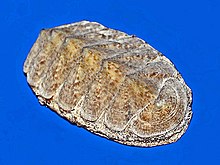Chiton olivaceus, the green chiton, is a species of chiton, a marine polyplacophoran mollusk in the family Chitonidae, the typical chitons.[1][2]
| Chiton olivaceus | |
|---|---|

| |
| Dorsal view of Chiton olivaceus from Sicily. Museum specimen | |
| Scientific classification | |
| Domain: | Eukaryota |
| Kingdom: | Animalia |
| Phylum: | Mollusca |
| Class: | Polyplacophora |
| Order: | Chitonida |
| Family: | Chitonidae |
| Genus: | Chiton |
| Species: | C. olivaceus
|
| Binomial name | |
| Chiton olivaceus Spengler, 1797
| |
| Synonyms | |
| |
Description edit
Chiton olivaceus can reach a length of 32–40 millimetres (1.3–1.6 in) and a width of about 16 millimetres (0.63 in). These large chitons have carinate plates with strongs ribs. The shell is oblong and oval. In the front and rear plates ribs have a radial pattern. The intermediate valves show a sharp beak and rounded sutural plates. Colors are very variable, ranging from olive-gray (hence the common name) to yellow-brown, sometimes black, orange, red or yellow. The girdle surrounding all of the valves is quite large and covered by bristles and scales.[3][4][5]
The teeth of these grazers of algae [6] are composed of magnetite, the hardest material usable by a living being.
Distribution edit
This species is common in the Mediterranean sea around Italy and Greece, but can also to be found in the nearby Atlantic Ocean.[7]
Habitat edit
Chiton olivaceus occur on a solid substrate, particularly stones and rocks, in the zones of sweeping of the waves, at a low depth.[3]
References edit
- ^ URMO: UNESCO-IOC Register of Marine Organisms. Land J. van der (ed)
- ^ WoRMS
- ^ a b Mondo Marino Archived 2016-03-04 at the Wayback Machine
- ^ "Area Marina di Portofino". Archived from the original on 2015-09-24. Retrieved 2015-09-03.
- ^ Wildlife Archipelago[permanent dead link]
- ^ D. I. MacKinnon,Daphne E. Lee,J. D. Campbell Brachiopods Through Time
- ^ SeaLifeBase